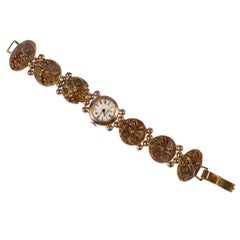Elsa Schiaparelli Watch
Recent Sales
Mid-20th Century Swiss Steampunk Collectible Jewelry
Metal
Elsa Schiaparelli for sale on 1stDibs
From her signature color Shocking Pink to her collaborations with Surrealist artists, the boldly original Elsa Schiaparelli transformed fashion with her haute couture house from the late 1920s to the early ’50s. Experimenting with elements like trompe l’oeil images and colorful visible zippers, the Italian designer instilled a provocative avant-garde artistry in her clothing and accessories, including those created with Salvador Dalí, such as the lobster dress and a hat shaped like a shoe.
Born in Rome, Schiaparelli was a rebellious child who grew up among the city’s intellectual elite. She had a voracious appetite for reading and became interested in ancient cultures, astronomy and world religions. Schiaparelli studied philosophy at the University of Rome, and after publishing a collection of poems on love and sensuality that so mortified her conservative parents that they tried, unsuccessfully, to confine her to a Swiss convent, she left for London.
A quick marriage to Count Wilhelm de Wendt de Kerlor brought her to New York, but it would be in Paris following her divorce that Schiaparelli embraced her artistic passions. She moved to the French capital city in 1922 with her young daughter and happened to meet master couturier Paul Poiret, who loaned the stylish Schiaparelli his clothes, sparking her own fashion interests.
Schiaparelli opened her modest atelier in Paris and debuted her first collection of knitwear in 1927, and later that year, she designed a black-and-white pullover hand-knit wool sweater featuring a trompe l’oeil bowknot that captured the attention of the fashion world. Vogue called it “an artistic masterpiece.” The success led to her moving her house to 21 Place Vendôme in 1935 where thousands of garments were produced each year.
Schiaparelli’s knitwear collections were later accompanied by revolutionary swimsuits and other clothing and accessories. Her inventive designs would include culottes — a radical statement in the 1930s when women still could cause a scandal by wearing pants — as well as printed fabric, such as the 1938 Tears dress with a print designed by Dalí making it appear as if the evening gown had been savagely ripped.
Schiaparelli was among the first designers to use materials like rayon and Lurex as well as explore wrap dresses and transparent raincoats. She also introduced unisex fragrances and brought her artistic partnerships into jewelry, such as bronze brooches made with Alberto Giacometti and fur-lined bracelets with Méret Oppenheim. As she wrote in her 1954 autobiography Shocking Life, women should “dare to be different.”
Despite her acclaim, her shop closed in 1954 after a tumultuous time during World War II. By then, fashion had moved on with Christian Dior's New Look, and the closure of Schiaparelli's business coincided with a comeback mounted by Coco Chanel, her archrival in the early days.
In 2006, Italian businessman Diego Della Valle acquired the brand and its archives, and the Maison Schiaparelli was reopened in 2012, back at 21 Place Vendôme where Schiaparelli's fearless and enduring work began.
Find vintage Elsa Schiaparelli hats, evening dresses and other clothing and accessories on 1stDibs.
Finding the Right collectibles-curiosities for You
Antique and vintage collectibles and curiosities can bring whimsy and wonder to any interior.
Decorating with old scientific instruments, historical memorabilia and vintage musical instruments, as well as other authentic collectibles and curiosities that can be found on 1stDibs, presents an opportunity to create a unique, natural history museum-like atmosphere in your home that can provoke conversation as often as it pays tribute to how far we’ve come in understanding our world.
And bringing collectibles and curiosities into your space is actually on trend — Wunderkammern, or curiosity cabinets, were all the rage in Europe during the 1500s and continued to have adherents there and in the U.S. in the following centuries. Today, however, they’re experiencing a real surge in popularity and influencing how many interior designers are furnishing and decorating homes — combining contemporary with antique, scientific with tribal, earthly with extraterrestrial, Les Lalanne tables with Flemish tapestries.
The original Wunderkammern were entire rooms filled with objects demonstrating their owners’ worldly knowledge: A proper one included artificiala or preciosa (objets d’art); naturalia (such as skeletons, shells, minerals); exotica (taxidermy or dried plants); and scientifica (scientific instruments), frequently alongside religious relics and ancient artifacts.
Pay tribute to a history of rich and diverse musical traditions that have taken shape all over the world by decorating your home with a collection of antique and vintage musical instruments — with a little help from strong hanging wire or some wall hooks, vintage brass instruments such as a gong, French horn or trumpet can help elevate a home office or complement the efforts you’ve made to ensure a welcoming vibe in your home’s entryway. Bells or antique wind instruments can add provocative metallic contrasts to dark woods as tabletop decorative objects.
Create an intriguing focal point with Georgian scientific instruments, such as stick barometers with mahogany cases or lacquered brass telescopes. These items stem from an era named for the monarchies of the four King Georges, who ruled England in succession starting in 1714 (plus King William’s reign, which lasted until 1837). Just as there was beautiful jewelry produced during the period that today is coveted by collectors, there is much to be found in the collectibles and curiosities realm too.
Wanderlust, nostalgia and a shared love of good design are contributing factors to certain trends in decorating — just as vintage trunks and luggage have reappeared as furniture or home accents in a bedroom or foyer, decorating with globes, maps or nautical objects is similarly rooted in the allure of travel and a penchant for the stylish finishing touch that collectibles bring to our homes.
Find a wide range of antique and vintage collectibles and curiosities on 1stDibs.
